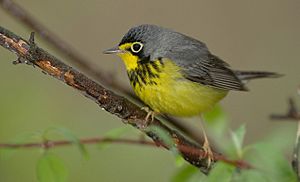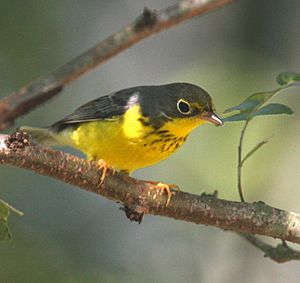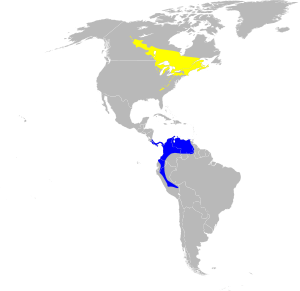Canada warbler facts for kids
Quick facts for kids Canada warbler |
|
|---|---|
 |
|
| Male | |
 |
|
| Female showing characteristic lighter neck markings and grey top plumage | |
| Conservation status | |
| Scientific classification | |
| Genus: |
Cardellina
|
| Species: |
canadensis
|
 |
|
| Range of C. canadensis Breeding range Wintering range | |
The Canada warbler (Cardellina canadensis) is a small songbird. It belongs to the New World warbler family. This bird spends its summers in Canada and the northeastern United States. In winter, it flies south to northern South America.
Contents
About the Canada Warbler
The Canada warbler is sometimes called the "necklaced warbler." This is because of the dark band of streaks across its chest. Adult birds are about 12 to 15 centimeters (5 to 6 inches) long. They have a wingspan of 17 to 22 centimeters (7 to 9 inches) and weigh 9 to 13 grams (about 0.3 to 0.5 ounces).
The bird's chest, throat, and belly are yellow. Its back is dark gray. It does not have special markings on its wings or tail. However, the underside of its tail is white. It has a yellow line near its eye. The most noticeable part of its face is the white rings around its eyes, which look like "spectacles." Young birds look similar to adults but have duller colors. Their face markings are also less clear.
What Does the Canada Warbler Sound Like?
The Canada warbler's song is loud and changes a lot. It sounds like "chip chewy sweet dichetty." Their calls are low "chup" sounds.
Where Canada Warblers Live
Most Canada warblers (about 82%) live in Canada during the summer. The rest (18%) live in the United States. In Canada, they can be found from southeastern Yukon to Nova Scotia. In the U.S., they live from northern Minnesota to northern Pennsylvania. They also live east to Long Island, New York. Some even nest in the high Appalachian Mountains as far south as Georgia.
In winter, Canada warblers fly to South America. Their winter home stretches from Guyana to northwestern Bolivia. This area is mostly around the northern and western side of the Andes mountains.
Canada warblers like wet, bushy areas. In summer, they nest near rivers, in brushy valleys, or in forest swamps. In the winter, they prefer higher places in the mountains. Sometimes, these birds are seen in places they don't usually live. For example, two were seen in Europe, one in Iceland in 1973 and another in Ireland in 2006.
How Far Do They Migrate?
The Canada warbler is one of the last birds to arrive at its summer breeding grounds. It is also one of the first to leave. They might only spend two months there. They fly at night, usually heading south and west to the Texas coast. Then they continue to southern Mexico. They arrive at their winter homes in South America in late September or early October.
Canada Warbler Behavior
How They Raise Their Young
Most Canada warblers nest in the boreal forests of Canada and the Great Lakes region of the United States. They also nest in New England and the Appalachians. These birds usually stay with one partner for at least a season.
Males arrive at the breeding grounds in early May. Females build their nests on or very close to the ground. They hide their nests in thick bushes or under roots, stumps, or mossy logs. The nests are often covered with moss.
The female lays four to five eggs. She sits on them for about 12 days until they hatch. The young birds stay in the nest for about 10 days after hatching. They depend on their parents for two to three weeks after leaving the nest.
The oldest known Canada warbler was found in Quebec in 1982. It was at least 8 years old!
What They Eat
Canada warblers mostly eat insects. This includes beetles, mosquitoes, flies, moths, and caterpillars. They also eat spiders, snails, and worms. Sometimes, they eat fruit.
They catch insects in different ways. They might scare insects out of leaves and then catch them while flying. They also search for food on the ground among fallen leaves. In South America, they often look for food with other birds. They usually forage about 1 to 9 meters (3 to 30 feet) above the ground in thick leaves.
Health and Threats
Sometimes, Canada warblers can get parasites. In 1947, a new type of worm was found in a Canada warbler in Virginia. Also, in the southern parts of their breeding range, cowbirds sometimes lay their eggs in Canada warbler nests. This is called nest parasitism.
Status of the Canada Warbler
Experts estimate there are about 1.5 million to 4 million Canada warblers in the world.
However, the number of Canada warblers is going down. Some things that threaten them include:
- Forest fragmentation: When large forests are broken into smaller pieces.
- Deer eating too many plants: Deer eat the low-growing plants where warblers like to hide and nest.
- Acid rain: This harms the forests.
- Woolly adelgid: This is an insect that kills fir and hemlock trees, which are important for their habitat.
Because of these problems, the Canada warbler population has been dropping by about 3.2% each year. The biggest drops are in the Northeast United States. In Canada, the species is considered "threatened." However, the IUCN (a global group that tracks species) lists the Canada warbler as a species of "least concern." This means it's not in immediate danger of disappearing, but its population is still being watched. The Canada warbler is protected by law in both Canada and the United States.
Canada Warbler in Art
The famous artist John James Audubon painted the Canada warbler. It is in his book The Birds of America, published between 1827 and 1838. The painting is called "Bonaparte's Flycatching-Warbler." It shows a female Canada warbler sitting on a branch of a magnolia tree.
See also
 In Spanish: Chipe de collar para niños
In Spanish: Chipe de collar para niños


